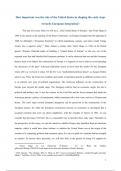How important was the role of the United States in shaping the early steps
towards European integration?
"The day will come when we will see [...] the United States of Europe", said Victor Hugo in
1849 in his speech at the opening of the Peace Conference. As Europe emerged from the uprisings of
1848, he defended a "European fraternity" in which populations, nations, and states would "merge
closely into a superior unity".1 Then, almost a century after Victor Hugo, in 1946, in his Zurich
speech, Winston Churchill spoke of building a "United States of Europe" as the way out of the
repeated wars that had bloodied the European continent. It can be observed that war and the European
project seem to be linked: the construction of Europe is a response to war in order to avoid repeating
the massacres of the past.2 American federalism seems to have been the 'model' for the European
Union (EU) as we know it today. Yet the EU is an "unidentified political object", as Jacques Delors
used to say. Thus, the Union has methods and modes of operation specific to different systems, but it
is an entirely new type of political organisation. The American influence on the construction of
Europe goes beyond the model stage. The European embryo had an economic origin, but also a
political and military one: it was the context of the Cold War and the Soviet menace that made the
Americans pursue a policy of containment, which sometimes led to new wars, such as in Vietnam and
Korea. The early steps toward European integration can be perceived as the construction of the
European project. So when the European construction became an institution so developed that it
accepted countries that were not direct neighbours, with the example of Greece in 1981, we can
consider that the frame 1947-late 70s is a reasonable way to describe these early steps. Therefore, in
the perspective of this essay, we can ask ourselves whether Europe only benefited from an American
impulse, which it could have done without, or whether the United States was at the origin of the
creation of a competing political and economic space. So, can we speak of a creature that has escaped
its master? To answer these questions, we will first look at the period of strong US support for
1
“Victor Hugo Et Les États-Unis D’Europe - II.” Le Blog De Gallica,
gallica.bnf.fr/blog/11042019/victor-hugo-et-les-etats-unis-deurope-ii?mode=desktop.
2
UNC Europe. “The Origins: Why Is There an EU? | Keys to European Politics | Liesbet Hooghe and Gary
Marks.” YouTube, 16 Oct. 2020, www.youtube.com/watch?v=IuOPEKm8MXk.
1
, European construction as a defence tool against the Soviet threat, from the end of the Second World
War to the late 1960s. Then, from the Nixon administration onwards, the growing economic and
political competition from the European Economic Community (EEC) led to a more ambivalent US
attitude.
At first, from 1945 to 1968, the American commitment in Europe was aimed at the
reconstruction of Western Europe to avoid a possible communist expansion.
First of all, it was the Truman administration that brought a change of heart. Indeed, 1947 marked a
turning point in American foreign policy. On 19 March, President Harry S. Truman presented his new
interventionist doctrine, which provided support for democratic regimes in the face of communist
regimes in the context of the Cold War. Truman charged George Marshall, the man most responsible
for the Allied victory as US Chief of Staff from 1939 to 1945, with the task of providing economic aid
to countries coveted by the Soviets.3 On 5 June 1947, in a speech at Harvard University, Marshall
announced his European Recovery Program, which provided capital, raw materials and machinery to
former allies - and enemies, since Germany was also concerned. The proposal was therefore addressed
to all the countries of the Old Continent, including the Union of Soviet Socialist Republics (USSR),
but the governments of the East refused it. Between 1947 and 1951, the United States provided almost
$13 billion in four years for European reconstruction, i.e. 1.5% of American GDP. And to distribute
the Marshall aid, the Organisation for European Economic Cooperation (OEEC) was created on the
American’s initiative in April 1948. It did not seek to form any kind of integration between its
member countries. But it greatly facilitated their trade by gradually reducing the quotas that limited
the quantity of each country's imports.4 Then, most of the countries that had accepted American
economic aid under the Marshall Plan also sought the military support of the US (and Canada) by
signing the "Atlantic Pact" in Washington on 4 April 1949. Even if the North Atlantic Treaty
Organisation (NATO) was mostly composed of European countries, it would in fact be entirely reliant
3
MILWARD Alan, The Reconstruction of Western Europe 1945-51, 1984
4
LUNDESTAD Geir, The United States and Western Europe since 1945. From ‘Empire by Invitation’ to
transatlantic drift, Oxford, OUP, 2005
2




